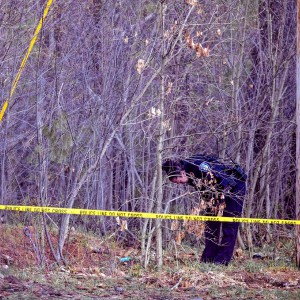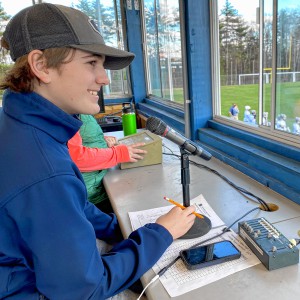Deadly Consequences: Police response to mental health calls prove fatal
| Published: 09-19-2023 7:07 PM |
Mischa Fay was like a lot of kids growing up around Lake Winnipesaukee – he liked boating, Star Wars and pizza. He also loved playing hockey, spending time with his sisters and cheering on the Boston Bruins with his dad. Known as kind and soft-spoken, he seemed on his way to a promising future.
But during 2022, Fay’s mental health began to decline. Records from the Gilford police department show that police were called to their home six times to assist his family as they dealt with his mental health issues and behavior.
Then, on New Year’s Day, Mischa Fay’s mother called 911 to ask for help with her son, who was acting erratically and armed with a knife, according to public reports.
At 9:56 p.m. on New Year’s Day, 2023, two Gilford officers responded to the Fay home. Both had been there before and were aware of his mental health struggles. Yet within two minutes, Officer Nathan Ayotte had fired his Taser – apparently with little effect – and Sgt. Doug Wall had fired a single shot into Fay’s chest, killing him. He was 17 years old.
Nearly nine months after Fay was killed, the New Hampshire Attorney General’s Office has yet to issue any report or ruling on whether the use of deadly force was justified.
It’s one of the clearest recent cases where a call for help during a mental health crisis led to a fatal police shooting, an ongoing pattern in New Hampshire.
More than 60% of people shot and killed by New Hampshire police over the last decade had a mental illness, according to a Concord Monitor analysis called “Shots Fired,” which was published in 2021.
Two years later, despite increases in training and awareness, those statistics remain unchanged. In the eight times police have shot and killed someone in New Hampshire since the analysis was published, five of those individuals had a history of mental illness, a rate of 62.5%.
Article continues after...
Yesterday's Most Read Articles
 A turbulent 50-year history: Inside the rise and fall of a tiny Catholic college in Warner
A turbulent 50-year history: Inside the rise and fall of a tiny Catholic college in Warner
 Update: Reactions for, against the more than 100 arrested at Dartmouth, UNH
Update: Reactions for, against the more than 100 arrested at Dartmouth, UNH
 Softball: Cassidy Emerson may have eight freshmen on her team, but the Falcons have glided to an 8-1 start
Softball: Cassidy Emerson may have eight freshmen on her team, but the Falcons have glided to an 8-1 start
 Franklin police arrest man after accidental shooting Wednesday
Franklin police arrest man after accidental shooting Wednesday
 Opinion: Sports have never been fair
Opinion: Sports have never been fair
 Hopkinton chocolatier transforms chocolates into works of art
Hopkinton chocolatier transforms chocolates into works of art
Some changes have been implemented, such as expanded Crisis Intervention Team (CIT) training for officers and the rollout of 988, a national mental health help hotline. But other potentially effective reforms, like the creation of a mental health incident review board, have gained little traction.
Obstacles to effective and humane responses to mental health crises remain, experts say, and greater investment in and attention to the issue is still needed.
“Do we need to change training? Do we need to change policies, practices and protocols?” asked Susan Stearns, the executive director for the National Alliance on Mental Illness of New Hampshire. “Unfortunately, the Attorney General’s role is so narrow, and I don’t think the Attorney General’s Office would disagree with us that we are missing the opportunity to learn and try to change our system going forward, in order to work toward preventing these tragedies.”
At 9:56 p.m. on Jan. 1, two Gilford officers arrived at the Fay home, and within two minutes, Sgt. Doug Wall fatally shot Fay a single time in the chest. Officer Nathan Ayotte fired his Taser.
Ayotte, who graduated from the police academy in 2021, is trained in jiujitsu and had recently completed a program to safely and effectively control resistive subjects. It was intended to reduce injury to both officers and suspects.
Wall has spent 28 years in law enforcement, 22 of those with the Gilford Police Department. He served four years in the U.S. Marine Corps and spearheaded the town’s Citizens Police Academy, according to Gilford Police.
Neither officer had any record of discipline at the department.
Initially, the two officers were put on paid administrative leave, but both returned to the force this spring after local officials determined they violated no town policies.
Even as the attorney general’s office continues to review the circumstances surrounding the shooting, the scope of the investigation is narrow. Prosecutors are weighing whether criminal charges should be filed against either officer, which is exceedingly rare in New Hampshire. State law justifies the use of lethal force if officers believe they or anyone else is in imminent danger.
The investigation won’t evaluate what could have been done differently to diffuse the situation or prevent harm to Fay. It won’t offer recommendations for Gilford or other police departments to follow when responding to mental health emergencies. It won’t address the ineffectiveness of the 988 hotline for families in mental health emergencies because of the hour or more it takes those teams of professionals to respond to a crisis.
The fatalities over the past two years underscore how complex it can be for police to respond to acute mental health crises, raising questions about how the situations could be better handled and, more importantly, how they could have been avoided.
The pattern is rooted in the failings of the state’s mental health infrastructure, which puts police and not health professionals at the front line of an emergency.
■Alex Naone, 26, of Hooksett, was fatally shot by police on May 26, 2023. Officials say he was armed at the time. The incident was recorded as a mental health issue in the dispatch log.
In his obituary, Naone is remembered as a loving, devoted father to his daughter and someone who would do anything for his family and friends. He was described as outgoing and a hard worker.
Like Fay, the death is still under investigation.
Michael Foley, 33, drove to the New Boston Space Force Station on May 13, 2022, armed with a knife and a pellet gun that resembled a real firearm.
Foley paced around his car but was unresponsive verbally to orders from security guards at the front gate. When police officers arrived, Foley did not respond to demands to drop the gun. Instead, he pointed the weapon at them.
New Boston police fired two shots, missing Foley, who was then fatally shot in the head by a security guard.
Foley had a history of juvenile depression, previous police encounters and recent interactions with suicide prevention resources. His texts revealed his emotional struggles, including a message about his desire to end his life: “I’m just letting u know I want to die. I can’t take it anymore. Everything is just crumbling.”
Christopher Coppola, 43, brandished a shotgun at one of his neighbors on the afternoon of April 9, 2022, as the man returned from buying pizza for his toddler’s birthday party.
Soon, Coppola fired at the man. The neighbor fired back with a legally licensed semi-automatic pistol he kept in the pickup truck and hit Coppola.
Wounded, Coppola sat against a tree in the man’s yard, while still holding the gun and “repeatedly told the police to shoot him.”
When one officer called for an armored vehicle to get close enough to restrain Coppola with non-lethal forces, he fired at the officers, who were not hit. Three officers responded by fatally shooting him.
The previous evening, Coppola had called 911 about suspicious vehicles, believing he was being watched. That evening and the next morning Coppola sent a series of paranoid texts to his sister and then to a friend, saying the opioid oxycontin had ruined his life. The autopsy report showed the presence of fentanyl in Coppola’s blood.
■On the morning of March 31, 2021, 40-year-old Jeffrey Ely was outside a commercial building near downtown Claremont where he rented space filled with automotive parts, a disassembled car, a bed, microwave and a large American flag.
An employee at the building called the police to report that Ely was “yelling, driving recklessly around the building, and threatening to ‘shoot everyone.’ ”
When Claremont police officers arrived, they found it “apparent” that Ely had “lost touch with reality” and attempted to persuade him to get treatment. Officers eventually left to plan how to “gain his cooperation” and possibly petition for involuntary emergency admission.
Hours later, Ely shot an AR-style rifle out his car window at three people; none were injured.
When police responded, Ely barricaded himself inside his shop and fired his weapon.
After officers tried for nearly four hours to communicate and de-escalate the situation, a SWAT team drove an armored vehicle to the back of the store and rammed the door open.
When Ely did not respond to multiple requests to drop his rifle, six state troopers opened fire, striking him multiple times until he fell backward.
After the initial volley of gunfire, one trooper said he saw Ely’s body move and shot at Ely three more times.
Thirty-six spent firearm casings were found where the SWAT team discharged their rifles. Ely’s autopsy report noted nine gunshot wounds: two to the head, one to the neck, two to the torso, three to the upper extremities and one to the lower extremities.
In the cases of Foley, Coppola and Ely, the Attorney General’s Office concluded that the deadly use of force was legally justified. Experts and advocates emphasize that such volatile situations could have been resolved differently, and ideally, before they reached a crisis point.
Mental health professionals in New Hampshire have called for a review process for police use of force in mental health crises separate from the Attorney General’s Office. State Senator Sharon Carson chaired a committee, launched in August 2022, to study the matter.
In its final report on Nov. 1, 2022, the committee recommended creating a Mental Health Incident Review Panel.
In her testimony, Stearns cited Ely’s case for its missed opportunities.
“These are tragedies for entire communities and for our state,” Stearns said. “Every single one of us, we have a responsibility to fix this because they are such tragedies,” Stearns said later in an interview. “It is our collective responsibility.”
The panel’s purpose would be to review incidents and identify best practices and opportunities for earlier intervention. Stearns said the panel is not meant for disciplinary review.
Other possible reforms include the expansion of police Crisis Intervention Team training, which was developed in 1988 by NAMI, police and other advocates in the wake of a fatal police shooting in Memphis, Tenn..
The 40-hour course, used by departments nationwide, aims to train law enforcement to better respond to mental health emergency calls.
In New Hampshire, NAMI presents CIT training to law enforcement officers and other first responders, often involving hearing from individuals who have experienced a mental health crisis, either firsthand or as a loved one.
Retired State Police Major Russell Conte, now the Mental Health and Wellness Coordinator, said the state police has over 130 troopers CIT-trained, which is over half its field force. That number was a “point of pride” for him.
Full CIT training will soon be incorporated into the police academy for new recruits. Previously, recruits participated in an 18-hour training also led by NAMI.
“We should be able to start providing this training at the basic police academy so people will, before they even start working, have this critical training and be able to de-escalate,” Conte said. “The team of first responders in the state are really recognizing the importance of changing a cultural perspective when it comes to dealing with people in a mental health crisis. I’ve been around a long time. To see that change in my lifetime is significant because when I started, we certainly didn’t have anything near what we needed.”
CIT training, touted as the “gold standard” by Stearns and Conte in separate interviews, is widely embraced by police departments nationwide.
However, a study published in the Journal of the American Academy of Psychiatry and the Law and posted on the NAMI-NH website raises doubts about CIT’s effectiveness. CIT training helps officer satisfaction and leads officers to perceive they are using less force, but there is scant evidence it actually reduces use of force, arrests and officer or citizen injury.
Experts nationwide have said it is far from enough to enable police to adequately respond to mental health crises. And an ongoing investigation by MindSite News and Northwestern University’s Medill School of Journalism found that officers who use force in mental health crises, including fatal force, are often CIT-trained.
Jamelia Morgan, a professor at Pritzker School of Law at Northwestern University, said mental health crisis intervention shouldn’t even involve the police. She said more funding should go toward alternative crisis intervention programs and to provide access to services creating a continuum of mental health care. Ultimately, she said, the way people think about mental health needs to change.
“We are seeing the violence because police are not supposed to be responding to people in mental crisis. It’s a public health matter, not a policing matter,” Morgan said. “We have inappropriate tools for this mental health response and those tools, when deployed against people in need of mental health support, can lead to violence.”
As a result, solutions are complex, she said.
“It’s a question of how we’ve structured our mental health systems in a way that they’re reliant on the police. It’s this really difficult paradox to untangle. All of the resources for getting someone access to emergency care, the vast majority of them are within the justice system whether it’s probation systems, jails or mental health courts.”
The 988 hotline is a relatively new national resource, launched as an alternative to 911 for people to call in mental health crises. Operators route callers to the Suicide & Crisis Lifeline, a national network of local crisis centers. The service is active across the U.S. through phone call, text or chat and can sometimes still involve the police through co-responder models.
New Hampshire’s version of 988, called the Rapid Response crisis system, officially launched on Jan. 1, 2022.
The helpline’s primary objective is to have a response team reach the crisis location within one hour. However, meeting this target can be challenging because the teams do not use lights and sirens while responding, like first responders, and they are thinly spread across the entire state.
In order to get more timely responses, New Hampshire residents are urged to call a harder-to-remember 10-digit helpline by dialing 833-710-6477. If they call 988 instead, the call is routed from a national call center back to New Hampshire and can lead to delays.
On top of those limitations, the system is struggling with dropped and abandoned calls, which are disconnected before reaching a live person, officials said.
Conte said that the hope is for 988 to get to a position where preventative help can be delivered before police are ever called.
“The police by nature, the uniforms they wear, the cars they drive, the lights that flash,” Conte said. “For somebody in a mental health crisis, many times just the presence of the police could escalate things. When you don’t have to have a police officer and there’s not that impending safety issue, you’re gonna have clinical people, peer specialists, people that can really take that person to a much better place, certainly mentally but also physically, and get them the services that they need.”
But there’s no competition between response times in times of emergencies when calling 988 and waiting an hour or more, versus calling 911, when first responders arrive in a matter of minutes.
Conte said that the 988 mobile crisis response program in New Hampshire is experiencing some growing pains in terms of geography and personnel.
This is especially true in rural areas, where 988 respondents can’t reach callers as quickly.
“When you go north of Concord, the population thins out but it doesn’t mean that you’re not going to have the same mental health needs,” Conte said. “I think the real challenge is going to be to ensure that mobile crisis has a link with first responders in all areas of the state – 988 is putting the emphasis exactly where it needs to be.”
He said urban jurisdictions often have 988 mobile crisis teams out every night, while in rural areas mobile crisis responders are reached on-call at home, and it can be time-consuming or difficult for them to reach the caller.
Conte said police officers would support efforts to divert more mental health calls that come in through 911 to 988 and away from law enforcement.
“If the police don’t have to be involved, I can tell you that law enforcement officers would be thrilled by that,” Conte said. “Many times, (a call) will come in as a suspicious person or a petty crime, and they’ll get there and very quickly they’ll know that it’s a mental health issue.”
If the issue was better identified as a mental health situation to begin with, first responders could help without channeling the person into the criminal justice system.
“Keep them out of that so that they can avoid the court system in totality and get themselves in a better place,” Conte said.
Morgan and other experts say more funding and attention is needed to help people with mental illness stay healthy on a daily basis and help their families know where to turn for help.
“It’s chronic care services,” Morgan said. “It’s the wraparound services and support for the family that’s dealing with the person in crisis. It’s putting a person back on their feet.”
Frank Knaack, the policy director of the American Civil Liberties Union of New Hampshire, said the conversation doesn’t stop with mental health.
“Our focus is trying to reimagine what safe and just communities should look like,” Knaack said. “For too long, we have come to rely on police and incarceration as ‘solutions to harms’ that are happening in our communities, anything from children misbehaving in schools to unhoused community members to people experiencing substance use and/or mental health crises.”
He said the vast majority of responses do not require police at all and that they’re handled appropriately and effectively by responders who have the tools to address the underlying issues they encounter.
“Oftentimes, these are not isolated incidents but they’re part of a holistic failure of society,” Knaack said. “So ensuring that people have access to adequate housing, access to a living wage – all of these are things that we think communities should be prioritizing if we actually care about public safety.”
A continuing obstacle to reform in New Hampshire and elsewhere is a lack of access to police records.
“I have no sense that policing is getting better than when I was a kid, but we don’t even track, it so I wouldn’t really even have a basis for measuring,” said Morgan.
Experts agree transparency is necessary for meaningful policing reform, including how police respond to mental health crises, but police in New Hampshire are slow or unwilling to provide data or records. The Concord Monitor requested mental health-related call records, use of force records and lists of CIT-trained officers from departments Manchester, Concord and the New Hampshire State Police as part of a joint investigation with the Medill School of Journalism at Northwestern University and MindSiteNews, which was seeking the same information from departments across the country.
Three months later, only Manchester Police had provided access to records, while Concord and State Police said they are not required to compile any records or that the requested records do not exist. By comparison, more than 40 cities nationwide provided such information within that time frame or had it posted on their public data portals.
This project relied largely on reports released by the Office of the Attorney General on fatal police shootings, which means police use of non-lethal force is not routinely investigated or reviewed by any state agency.
When Conte sought information on police response to mental health calls for a grant, he said he used the same Attorney General reports, which only include fatalities. No statewide database exists that tracks use of force incidents.
Even with the Attorney General reports, Knaack told a legislative committee in September 2022 that New Hampshire lacks “basic data around what is happening in terms of police killings.”
The Washington Post has published a national database of fatal police shootings since 2015. The database identifies nine police shootings in New Hampshire as mental-health related, while the Concord Monitor identified those and three additional shootings as mental-health related in the same timeframe from 2015 to 2021. Knaack said the Washington Post and the Concord Monitor are reporting different numbers due to the absence of a uniform methodology.
“At the New Hampshire state level, we are asking legislators and policymakers to make decisions on issues of extreme importance like this without actually knowing what’s happening on the ground,” said Knaack. “The fact that we don’t have any type of statewide data collection with consistent definitions to actually understand what is happening on the ground is problematic.”
Editor’s note: This story is the first part of an ongoing investigative collaboration between media outlets including the Concord Monitor, MindSite News and the Medill School of Journalism, Media & Integrated Marketing Communications at Northwestern University exploring police response to mental health crises. Additional reporting by Sruthi Gopalakrishnan.


 New Hampshire jury finds state liable for abuse at youth detention center and awards victim $38M
New Hampshire jury finds state liable for abuse at youth detention center and awards victim $38M Jurors hear closing arguments in landmark case alleging abuse at New Hampshire youth center
Jurors hear closing arguments in landmark case alleging abuse at New Hampshire youth center Voice of the Pride: Merrimack Valley sophomore Nick Gelinas never misses a game
Voice of the Pride: Merrimack Valley sophomore Nick Gelinas never misses a game
